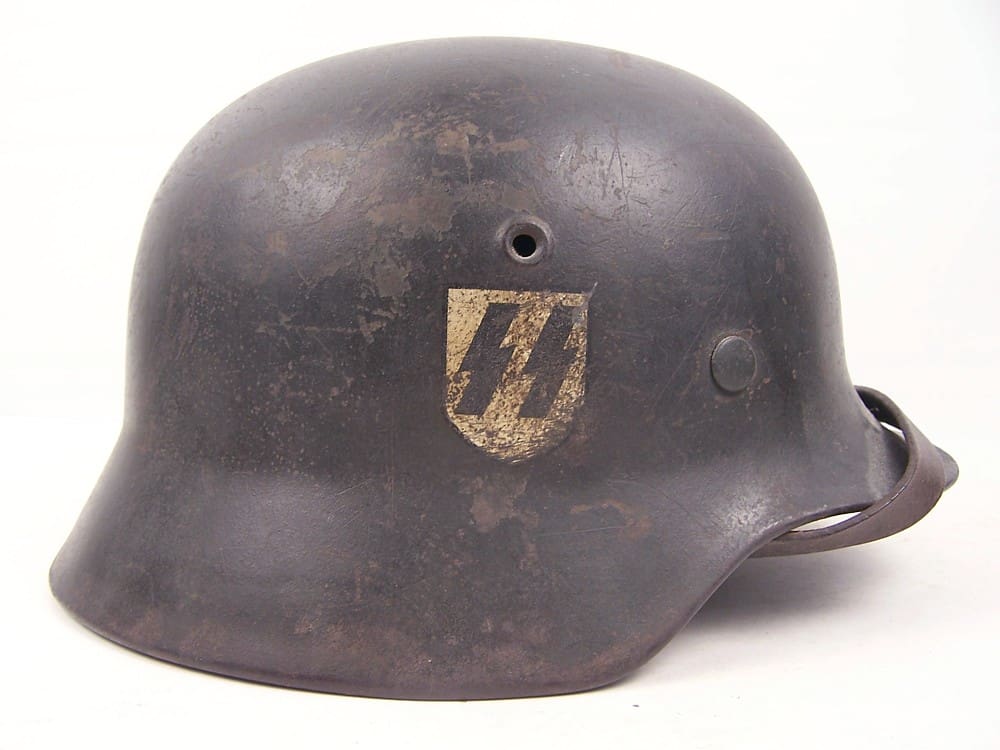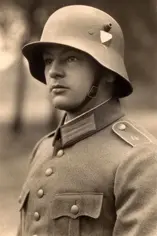
Understanding WWII German helmet insignia
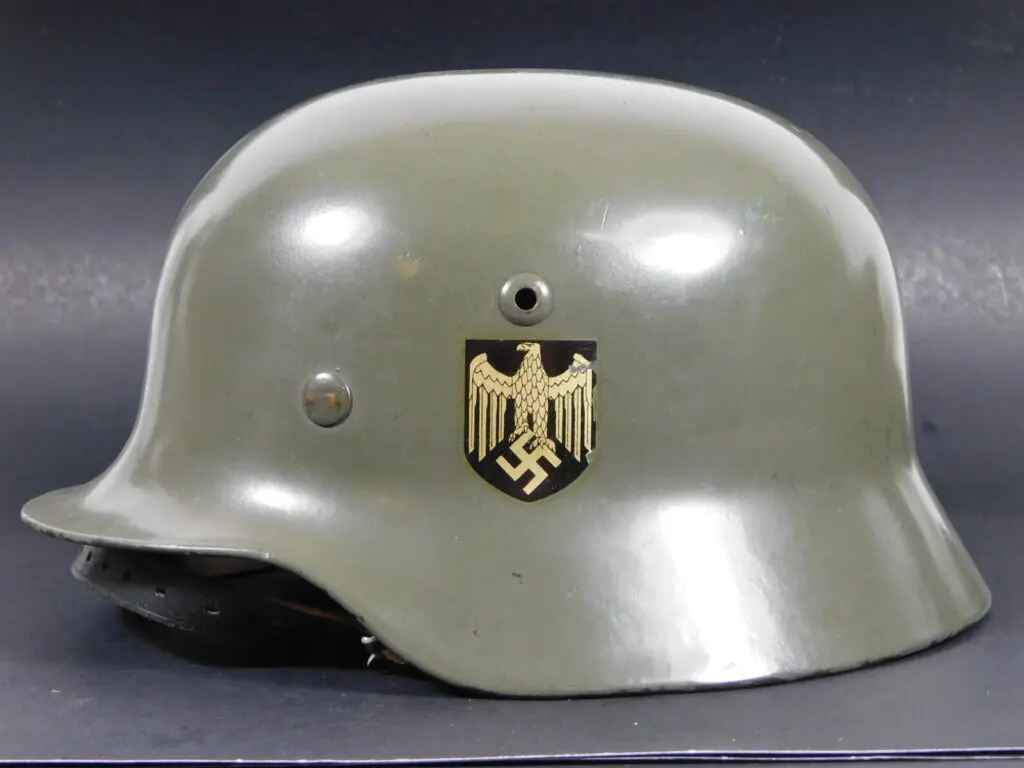
There maybe no more iconic item from the Second World War than the double decal German helmet. Most people, even those who know little about the history of WWII can easily recognize one of these helmets. From the comical Sargent Schultz of Hogan’s Hero’s fame to more recent films Hollywood has cemented the double decal helmet as the predominate headgear of the WWII German soldier into the consciousnesses of modern culture.
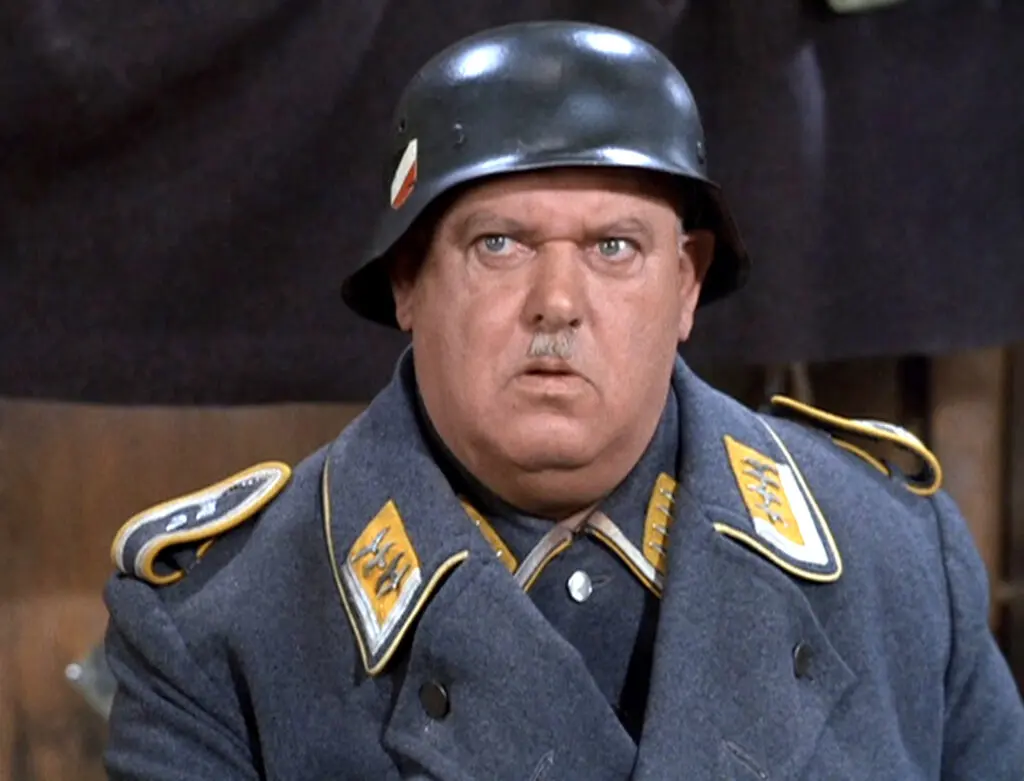
While it is certainly true that the German armed forces did wear helmets with decals on them the use of a double decal helmet was far from predominate. In fact the German high command ordered the so called double decal helmet phased out before the invasion of France in 1940. The use of decals by the German armed forced is a interested and to some degree complex story. It is without a doubt worth understand by anyone interested in the history of WWII headgear.
Helmet Insignia from the Great War
The use of helmet insignia by the Germans actually starts back in the First Word War. Sometime in 1917 troops from the 1st Foot Guards Regiment and the 1st Guards signal battalion took to wearing a Hohenzollern crest on the left side of their helmet with the company number painted in white, red or in some cases black on the back of the helmet. The crests were hand rendered and surviving examples show a wide variety of sizes and styles. This is undoubtedly due individual artist’s varying skill. Documentation is limited on the history of these crests but photographic evidence as well as surviving original helmets do exist confirming their use.
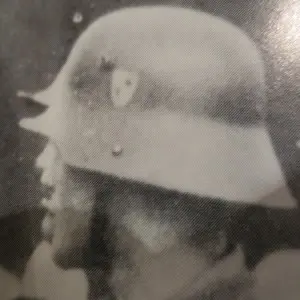
on this M16 helmet
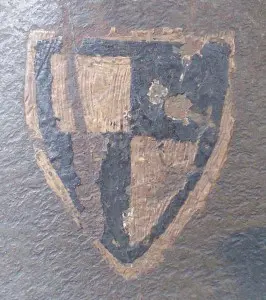
Hohenzollern shield
Aside from the Hohenzollern crest there is at least one more type of insignia found on Great War era German helmets. Over the years a few German helmet have been found bearing a hand rendered Machine gun, usually on the wearer’s left. The conventional wisdom is that these helmets were worn by members of machine gun crews. The lack of war time photos showing the use of these helmets have made many question as to whether these helmets are nothing more then post-war vet art. The existence of the many recorded veteran  accounts of German machine gunners being executed upon capture, does raise a few questions about the use of these insignia. German machine gunners undoubted knew what their fate might be should be be taken alive so the idea of advertising their position on their helmet does seem unlikely. That being said there may well have been some men who painted the machine-gun on their helmets as an act of bravado. Until some long forgotten veteran account or photograph evidence surfaces the use of these insignia in the field will remain unconfirmed.
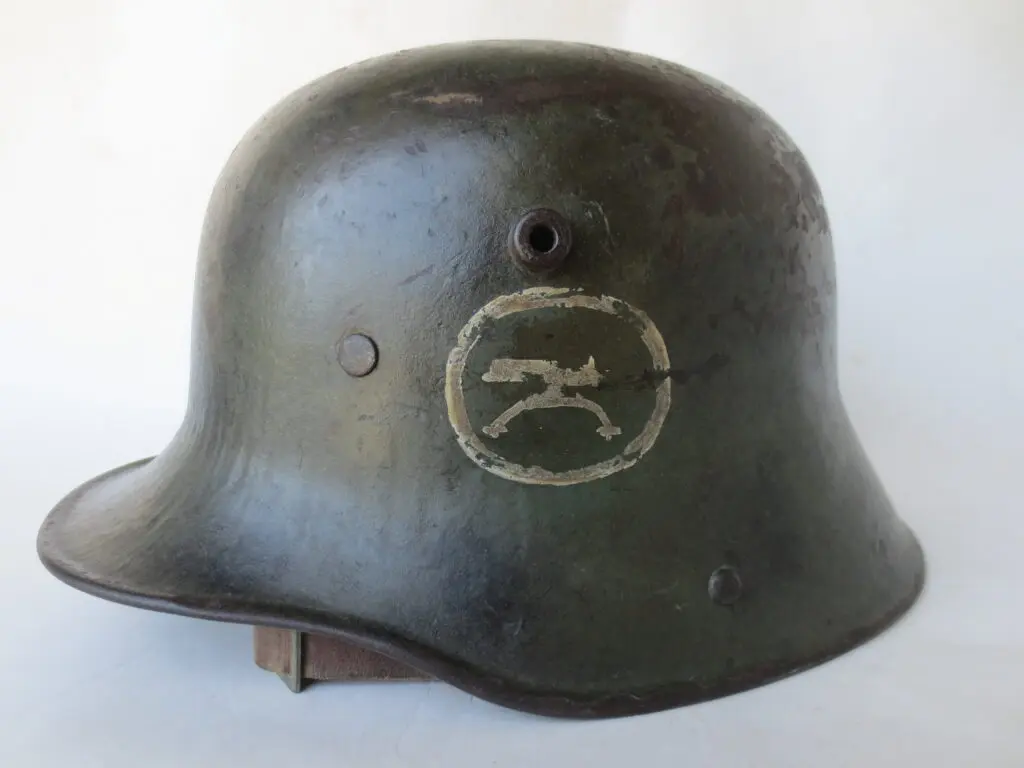
This helmet was procured from an American WWI veteran’s estate in the 1960s
The Freikorps
After the fall of the Kaiserreich in 1918 it wasn’t long before German helmets with new insignia were being used. Between 1919 and 1920 paramilitary units known as the Freikorps battled communists in the streets of Germany, Latvia and Poland. These forces used hand rendered insignia on their helmets to identify their individual units. There were a number of different type of insignia used by these men. Photos taken during the March, 1920 Kapp Putsch show men from Freikorps Ehrhardt wearing large swastikas painted on the front of their helmets.
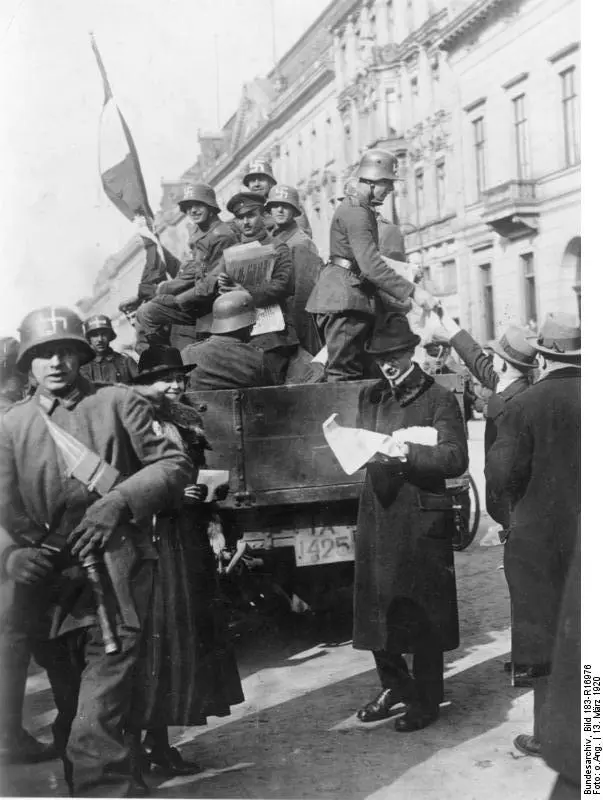
Other Freikorps units used their state colors to create a recognizable insignia while others choose a symbol in which to designate their unit. Freikorps Hacketau as well as the so-called Iron division had one of the more memorable devices of the era, a large death head painted in silver or white paint on the front of the helmet. Whatever the insignia used it is clear that as time went on the helmet was seen more and more as the preferred method of displaying the designation of the wearer unit.
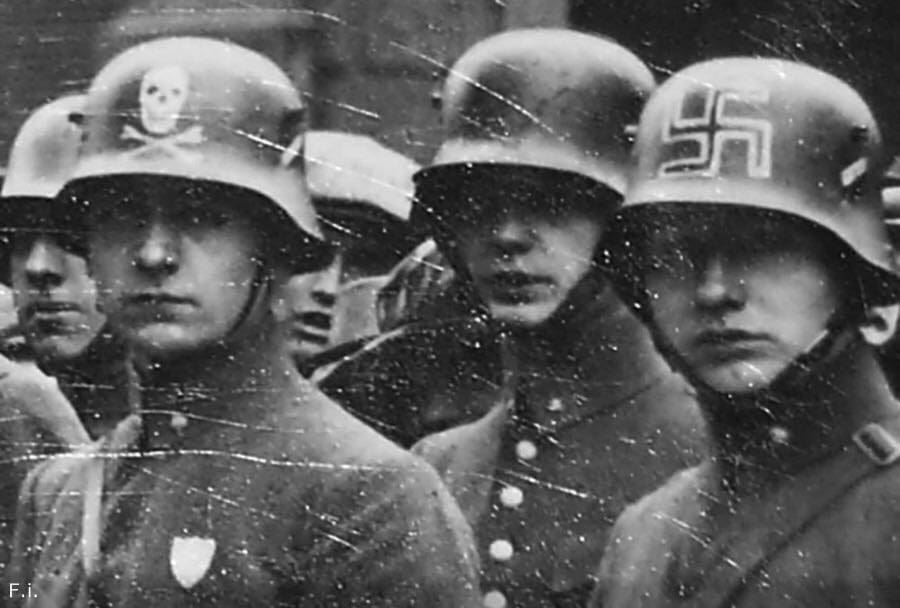
The Weimar Era
When the Reichwehr was established as the new German defense force in the aftermath of the Great War no helmet insignia was authorized. On January 1st of 1921 new uniform regulations were established. While the new regulation said nothing about the helmet a letter from Wehrkreiskommando VII (7th defence district command) written to the various Bavarian Reichswehr units stated that a small white and blue shield (colors of Bavaria) should be painted on the left side of the helmet. A hand written notation on the letter indicates the order had received approval from the Reichswehr ministry. The exact date that these shields were to be applied to the helmet is not known. What is known is that a statement issued from the  Reichpresident on April 19th of 1922 made reference to a shield shaped insignia or Wrappenschild  which would display the colors of the providence where the units was assembled.
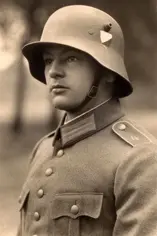
The size of the shield was specified as being 3.4 cm high and 3.0 cm wide. Surviving original helmets from this era show a few different version of these shields. The shield were hand rendered. As with the Great War era Guard regiment insignia artistic skill does play a factor in the quality and appearance.

The Wrappenschild is clearly visable
On January 26,1924 the German Navy or Reichsmarine introduced their own insignia. The insignia consisted of two crossed gold anchors on a white field. Very few original Reichsmarine helmets have surfaced. While helmets from this era always feature a hand rendered insignia a few Reichmarine helmets have been found with decals. Little information exists on these decals, and some have been panned as post-war fakes by collectors while others do in fact appear to be original. That being stated, with the complexity of the insignia it maybe that the Reichsmarine experimented with a decal. Undoubtedly this would have been easier to apply to the helmet then painting the cross anchor insignia by hand.
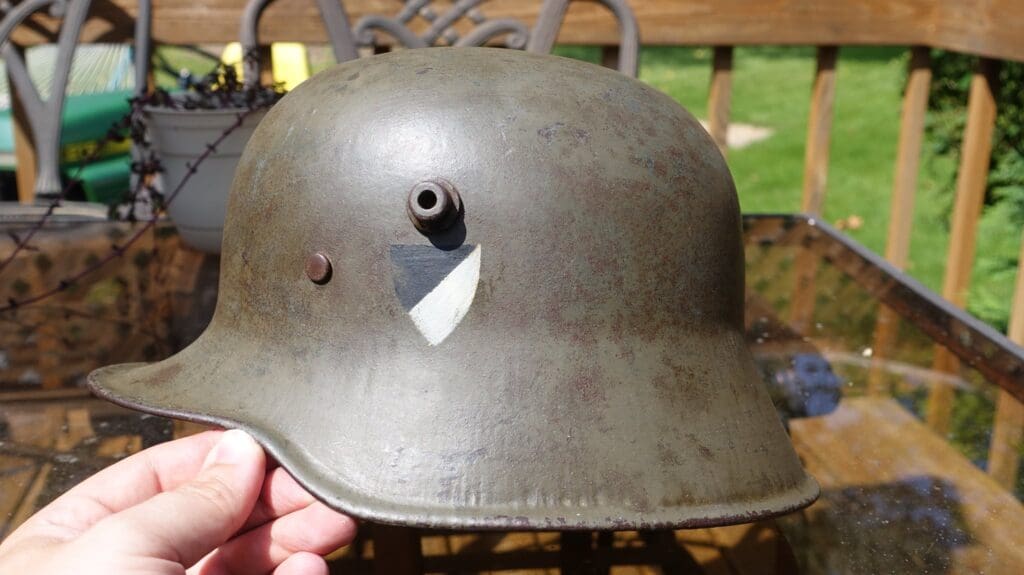
The Third Reich Era
After the National Socialists rose to power on 30 January 1933 the helmet insignia would change once again. On 14 March 1933 the Reichspresident issued a decree that all the provincial insignia and navy anchor crest were to be replaced by a shield of the same size based on the colors of the Reich battle flag (black/white/red). The new insignia was to be positioned on the wearer’s left
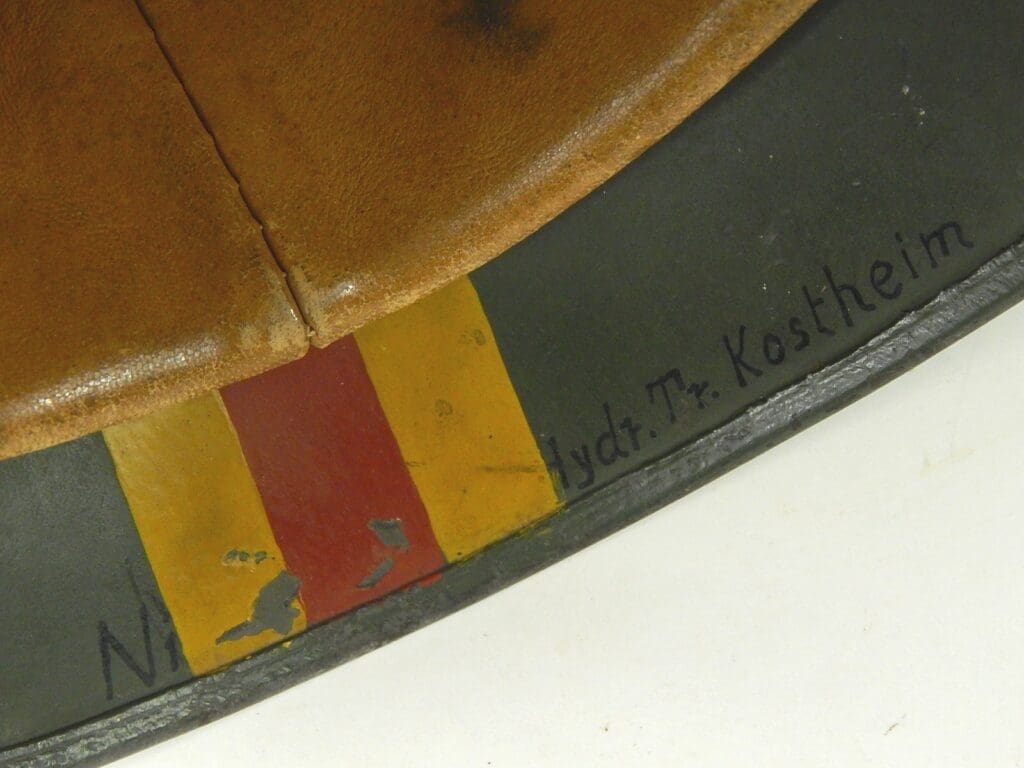
The order was only temporary, on February 17th 1934 the shield was ordered moved to the wearer’s right. . These late Reichswehr helmet are unique as surviving originals show a mixture of hand rendered insignia and insignia in decal form. It was without a doubt realized that decals were easier to apply then to paint the insignia by hand. The decal also had the added advantage of uniformity, something not easily accomplished by a wide variety of painters with varying degrees of artistic skill. A surviving memo issued by the Reichswehr ministry dated 5th of April 1934 offers some insight into the use of national colors decals at this time. The memo mentions that the new national colors decals were to be sent out to individual units and immediately applied to the helmets by them. The memo stated that the decal was to be placed exactly, “3 mm under the ventilation lug and mid-line of the insignia must pass though the center of the vent…”. The memo also stated that the old insignia were to be removed. This memo indicate the importance that the high command placed on the uniformity of these insignia which could only be accomplished via a decal. From this point on the use of hand rendered insignia would diminish in favor of printed decals.    It should be noted that more then a few helmets from this era have been found with provincial colors painted on the inside of the helmet’s skirt. This may have been a way for some regiments to continue the Reichswehr tradition of marking the helmet for the individual German states long after the order was issued to remove these provincial shields. The use of the Reichswehr national colors decal was temporary. New decals were in the works. A Reichswehr order dated 5 April 1934 stated that new decals were to be issued out to all units. The news decal would consist of an national colors decal for the right side. The decal for the left side of the helmet would have an eagle with folded down wings clutching a swastika in its talons, the very symbol of the new regime. The eagle was silver for army units and gold for the Navy. The new decals were made of flax-oil varnish with the eagle made of foil. The new decal were applied to the helmet by brushing a thin layer of Ducolux, Kopal or Damar varnish onto the painted surface of the helmet then placing the decal over the tacky varnish. Once the decal was firmly bonded to the surface of the helmet a protective layer of varnish was painted over the decal. As time went on the last step of applying the protective layer was often skipped.
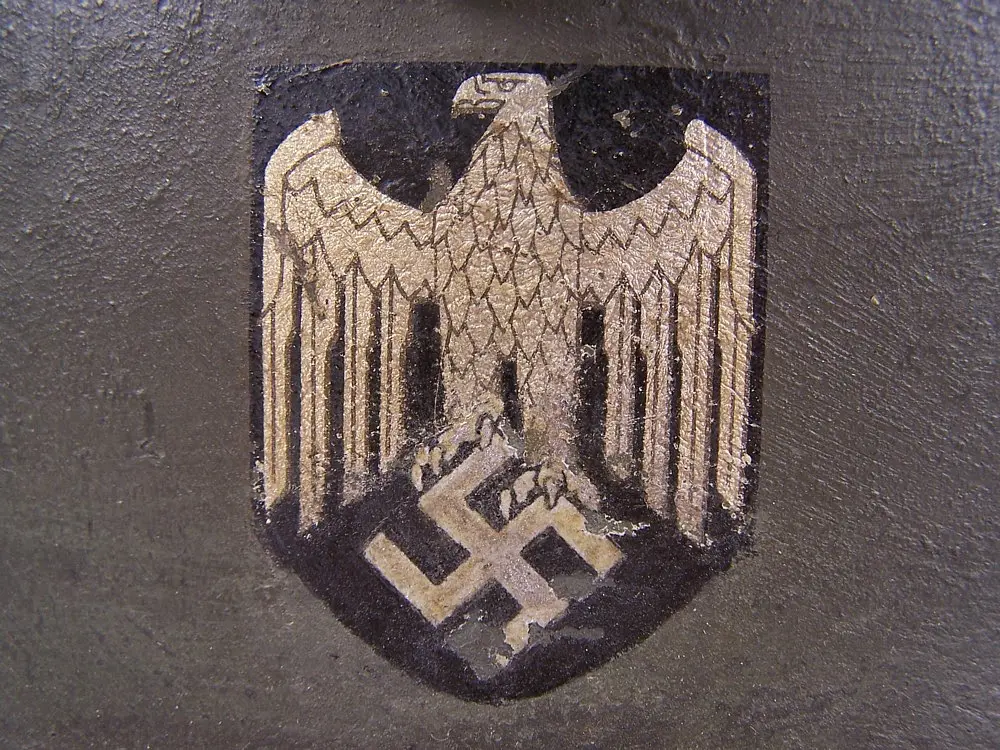
These early decals are often called “dry transfers”. It appears that the application of was found to be difficult, and new water transfer decals were developed. The water transfer decals were much easier to apply and did not take near the amount of time needed to apply the dry transfer version.
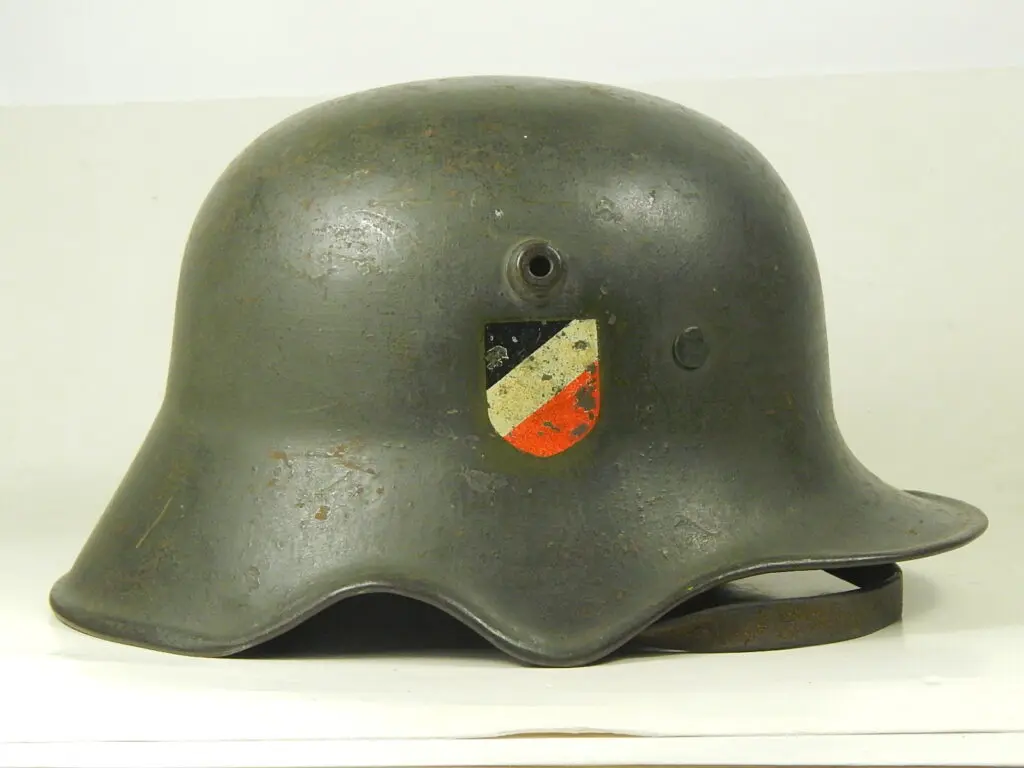
It should be noted that several different firms were contracted to produce decals. Decals from these different firms show slight differences. While the discussion of these differences is beyond the scope of this article it should suffice to say that such differences do exist.
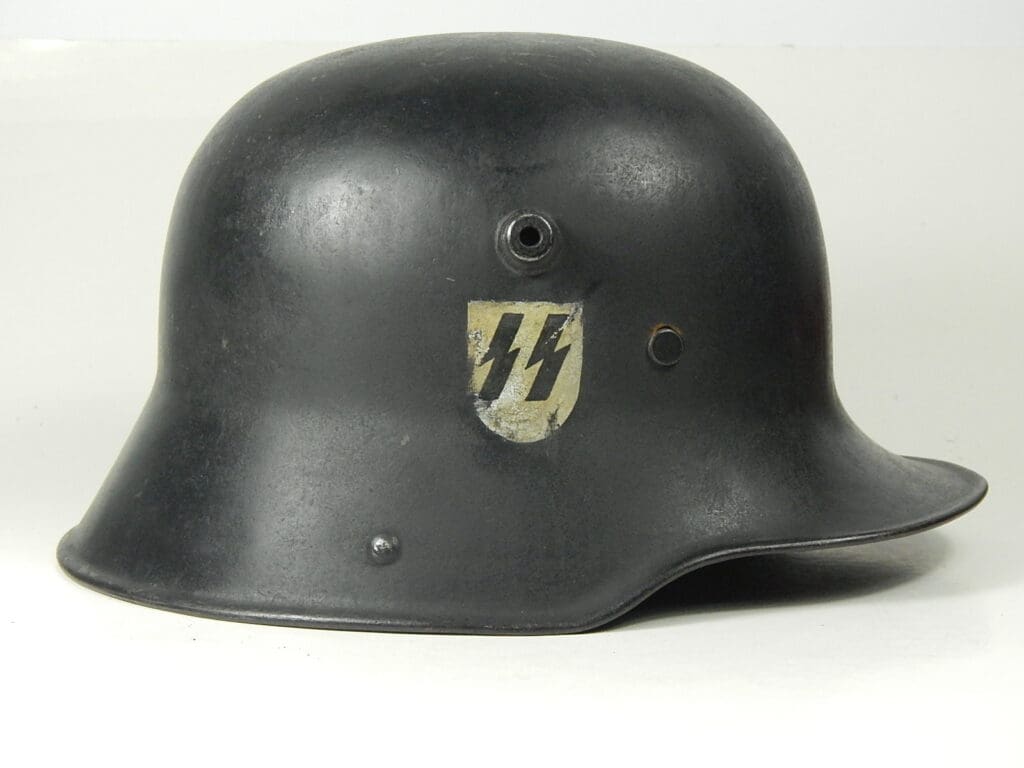
with hand rendered insignia. This helmet likely dates to 1935
The SS
The SS went though a similar evolution in the use of helmet insignia. Early SS helmet from the 1920s do not have any insignia whatsoever. At some point the some SS units began using a white bordered black swastika hand rendered onto the left side of the helmet. In same cases the swastikas were white. Between 1934 and 1935 the different divisions within the SS units a number of different insignia configurations. Just like their Freikorps predecessors these insignia served to differentiate between the units within the SS. All of these insignia were painted by hand or applied by ways of a stencil. At least one SS-SS-Verfügungstruppe black parade helmet helmet has been found with a celluloid decal. It is likely that the SS-SS-Verfügungstruppe experimented with the use of decals just as did the Reichwehr.
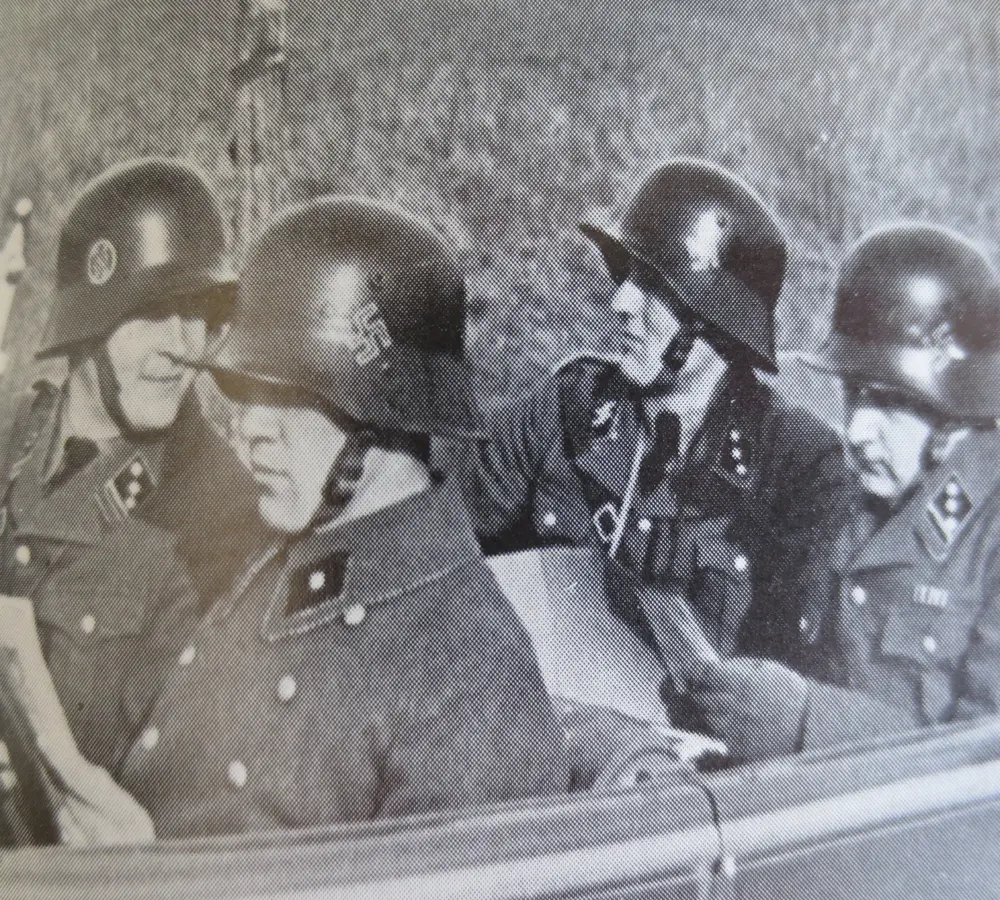
The men here wear Austrian M17 helmets
with hand rendered insignia
On August 12 1935 a new order was issued by the Chief of the SS-Headquarters. The order stated that new insignia would need to be applied to all SS helmets. The order indicated that SS runes on a silver shield would be painted on the right side of the helmet while a swastika on a red shield would be painted on the left side of the helmet. The order specifically states that the insignia were to be painted in oil.
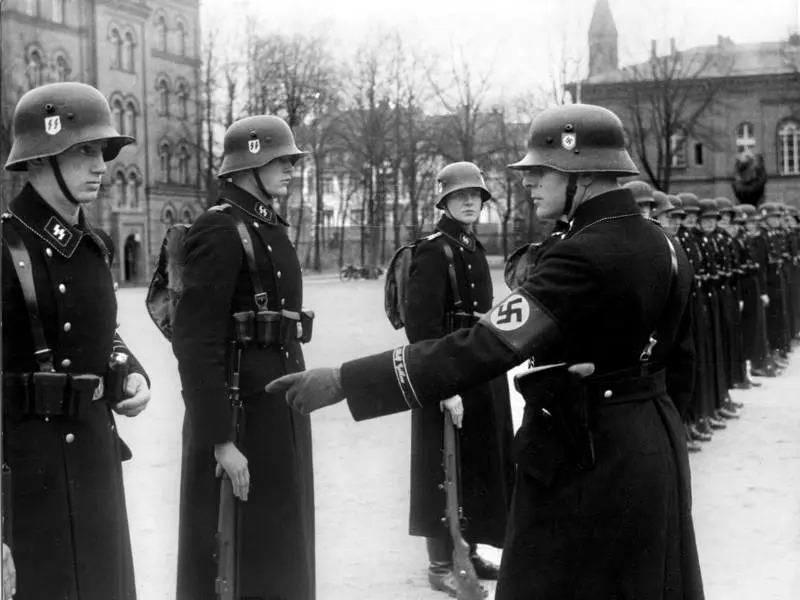
interestingly an addendum to the order was issued two days after stated that the insignia were to be applied in the form of decals. A few SS helmets from this time period have turned up with hand painted decals. While it may be possible that these helmets had the insignia painted onto them in the two days between the initial order and addendum or more likely the SS equipment depots were slow at receiving the new decals and to comply with the new order the depots simply painted the new insignia onto the helmets in their possession. Â
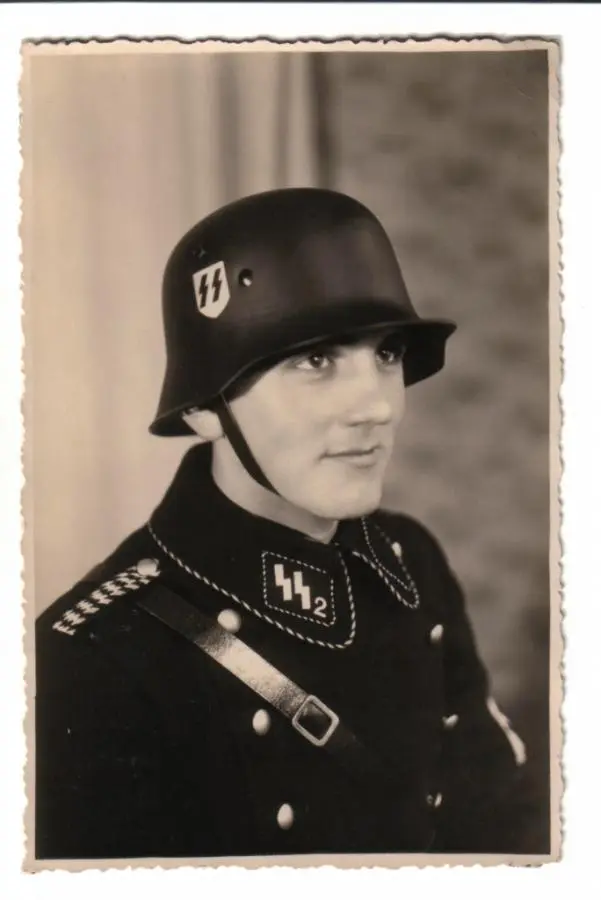
Starting in 1936 SS unit would began to receive the new M35 helmet. The new helmet would slowly replace the older WWI era helmets the SS had been wearing since the 1920s. The new helmets came from the factory with decals already applied
As with the decals worn by the Wehrmacht, there are subtle difference between decals applied at the five different factories which manufacture helmets for the SS. Heated debates rage on collector’s forums and Facebook groups about these differences and what they mean. Suffice to say there are differences and for any collector who wishes to add an original SS helmet to their collection it is imperative that they understand these differences.
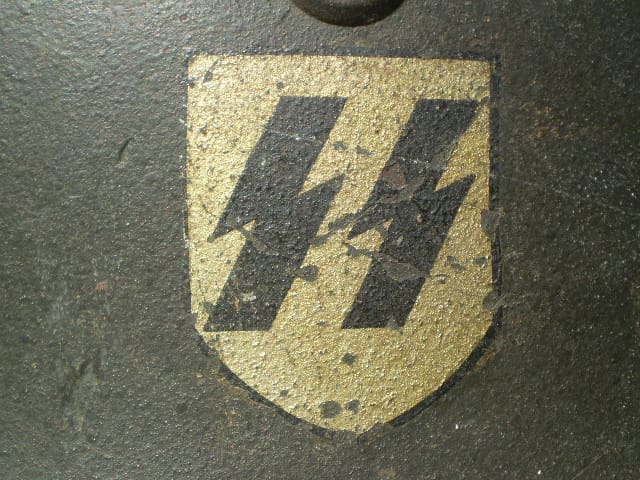
Changes after Poland
After the invasion of Poland in 1939, changes to the use of decals would come again. In March 21 1940 the German high command ordered the helmets to be repainted with a rough textured dark field gray matte paint. The order also specified that the red, white, and black national colors decal would need to be removed from existing helmets and the factories were ordered to no longer apply these decals. The order states that this measure is being taken for camouflage purposes, and recommended that those units which were unable to acquire matte field gray paint should camouflage their helmets by means of smearing the finish with mud and clay or use a net or cover. The order was in response to the experience faced by German unit is Poland. The smooth painted used on helmets proved to reflect sun light, and the highly visible national colors decal without a doubt was used by Polish marksmen to great effect.Â
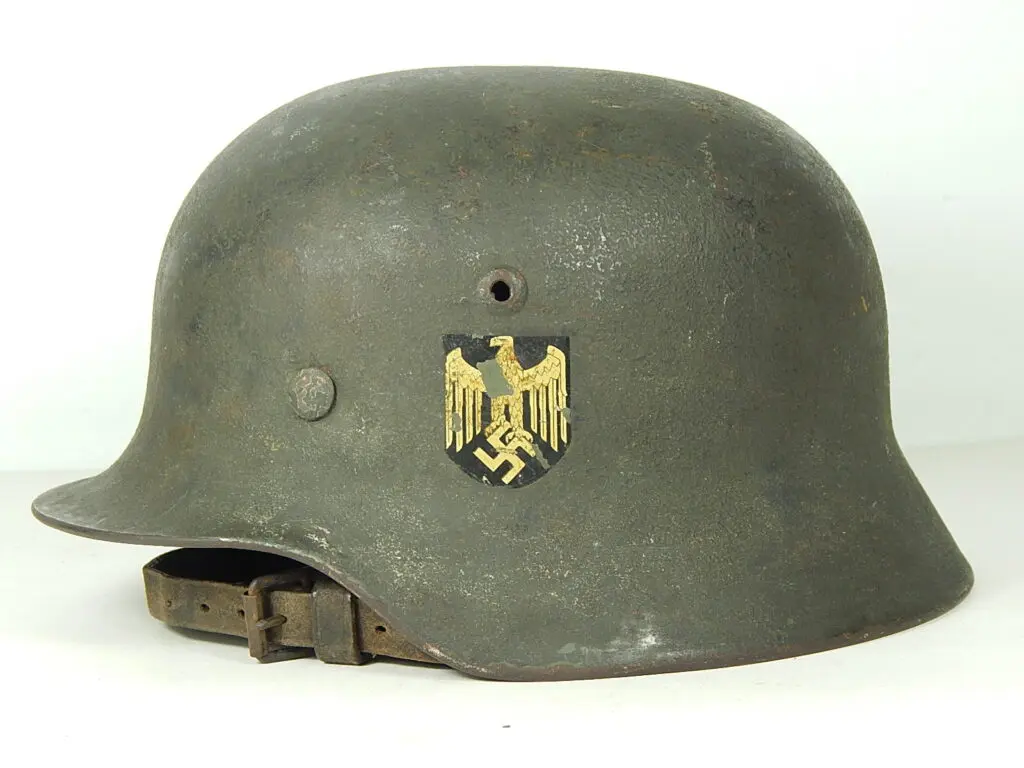
The paint applied per the March 1940 regulations, the national colors decal was painted over in this case
Note the M27 Reichwehr era chinstrap Â
Oddly the March 1940 order was only issued to German army, no mention is made of the Luftwaffe, Navy or SS.
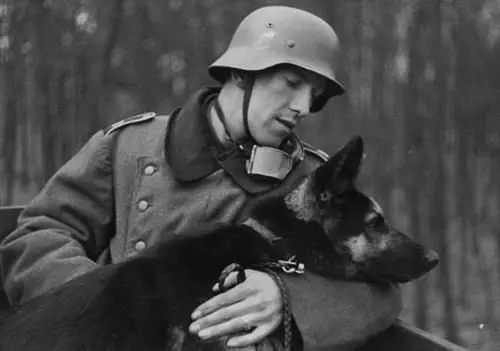
away for purposes of camouflage or to comply with the March order.
This may have been an oversight. A order was issued to Luftwaffe units on 12 June 1940 that stated that the use of the national colors decal would be discontinued. The SS would receive a similar order in August of 1940. A new version of the German helmet began to be issued out to German units in March of 1940. These helmets are known to collectors as M40s. A very small number of these M40s have been found with double decals. Research on the heading lot numbers of these helmets indicate they were made prior to the orders. In some cases a few SS M40 double decal helmet have turned up where the lot number indicates the helmet was made well after the order. It is believed that these helmets may have been worn by members of the SS who worked in concentration camps. The Nazi party decal may have been applied by camp supply depots or by the individual guards perhaps for political reasons or for the intimidation of the inmates.
In the cases of the double decal army helmet when the date of the decal removal order coincided with the first issue of the new M40 it can be assumed that the factory had not received the order and issues out a small number of M40s with both a national colors decal and army decal.
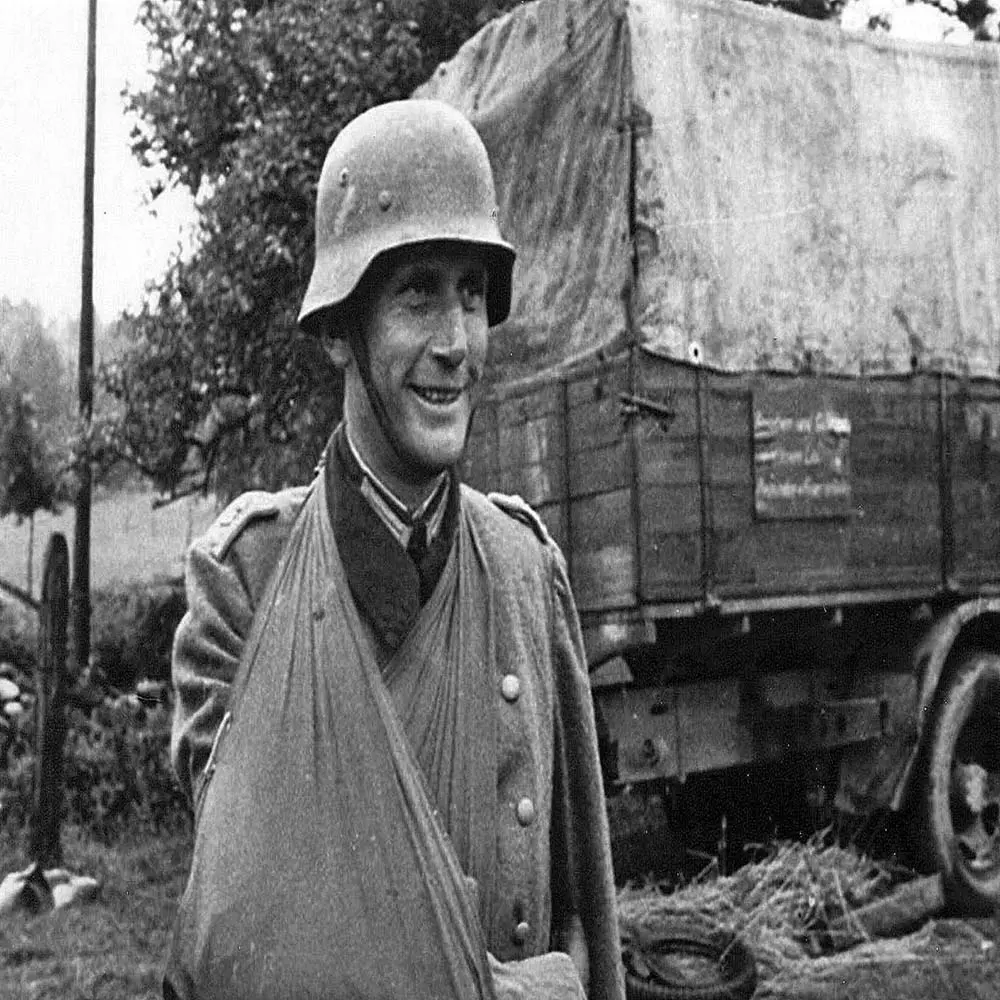
While the order clearly stated that the SS party, and national colors decals were to be removed photographic evidence shows the use of double decal helmet until the end of the war. There maybe different reasons for this. Some men, officer or NCOs may have used these helmet to distinguish themselves as leaders in their unit. Other men may have kept the decal to show their long service, as having been issued the helmet before the war, making them a recognizable old hand. Still others may have been stationed in quiet areas of occupation such as Norway or France. They saw no need to comply with an order designed to camouflage the helmet for combat in an area where combat was not taking place. Some photos taken in late 1944 and 1945 show men wearing these double decal helmets. Due to sever supply shortages the German forces were experiencing at that time, these helmets may have been pulled from the regimental parade equipment and issued out.
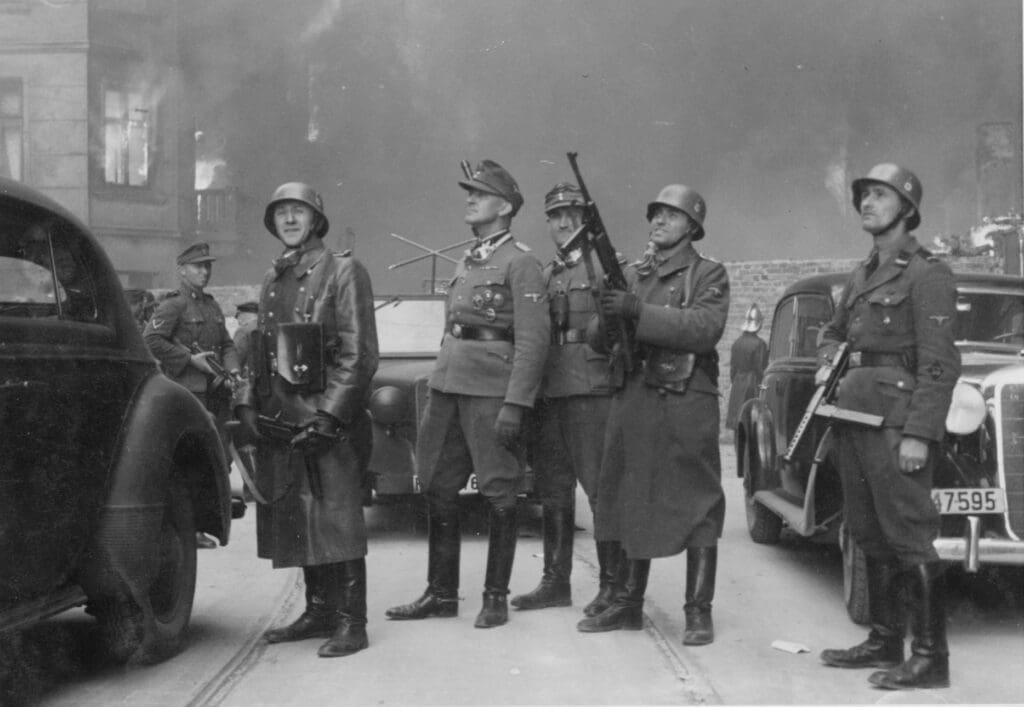
While the German Army, SS, Navy and Luftwaffe were all under order to remove the nation colors German police units were never ordered to remove the party decal on their helmets. Police units would continue to wear both decals until the end of the war.
No major changed were ordered for the use of decal between 1940 and 1943. In August of 1943 a final change was issued. On August 28th of 1943 an order was issued to the five different factories that made helmets to no longer apply decals. The order stated that the application of decals regardless branch of service were to be discontinued. Police units who received helmets without decals applied the decals themselves when decals were available. The order seems to have been carried out fairly quickly. Helmets with heating lot numbers that tie their production to end end of August and into September generally do not have decals. There are some exceptions, though, which could be the result of the helmet having the decal applied in the field or the result of post-war forgery.
A lot of discussed has taken place as to the reason for the decal drop in 1943. One school of though is that the order was issued for the same reasons as the order to remove the national colors and party shield was. This seems unlikely. The order was issued to the factories and not to the men in the field. If the high command had been concerned with the decal presenting a danger to men in the field, why was an order not issued for men in the field to remove the decal? With the many surviving German helmets with intact decals, and the camouflaged helmets where the decal was carefully painted around, its seems unlikely that men in the field saw the exposed decal as much of a threat.
The fact of the matter is the decal and its application was costly and time consuming. By halting the application of the decal the factory could save time and money. It should not be surprising that the decision was made at the same time as an order to discontinue helmets painted in Luftwaffe blue-gray. From that point on the factories would produce one type of helmets, painted field gray with no decal which could be issued to all troops regardless of branch of service. This would have certainly saved money and streamlined  production, at a time when the war was already turning against Germany.
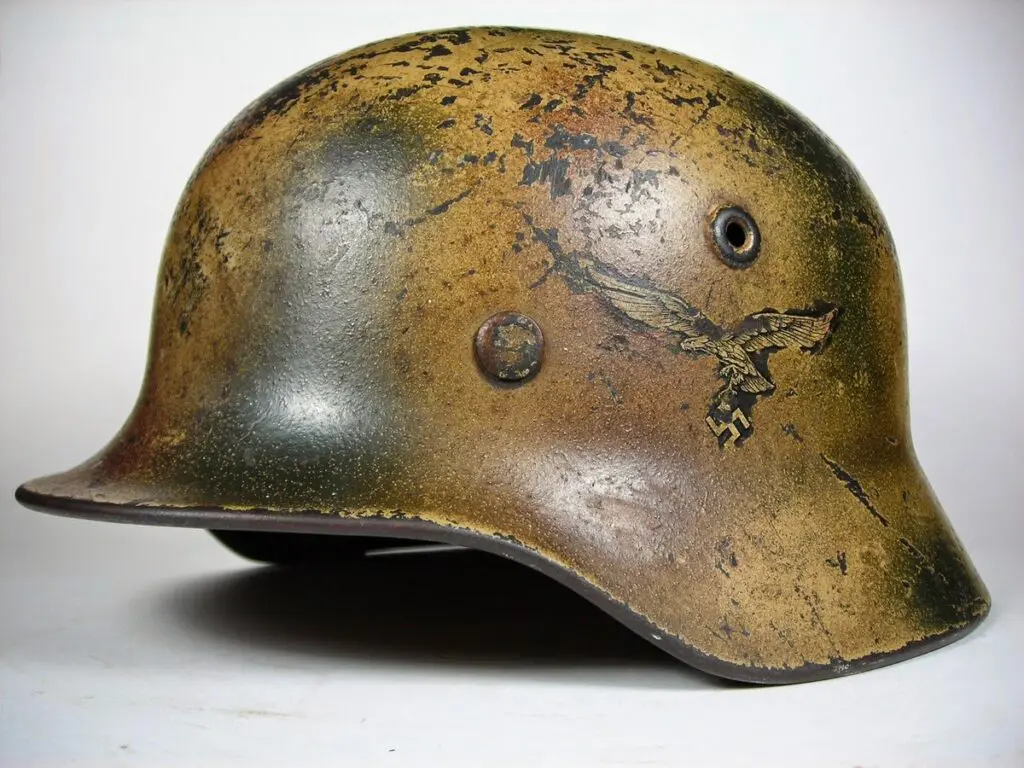
While German helmet factories would continue to produce helmets without decal, hundreds of thousands of  helmet with decal would continue to see action on all fronts to the end of the war. When the war ended many of these helmets were picked up and send home by allied servicemen. Helmets with decals were without a doubt popular with the vets. It may be that they saw the decals with their political symbols as a representative of the regime which they had helped to defeat. While before and during the war these decals only were meant to indicate the wearer’s branch of service today, they serve as a recognizable representation of the largest war of all times.
